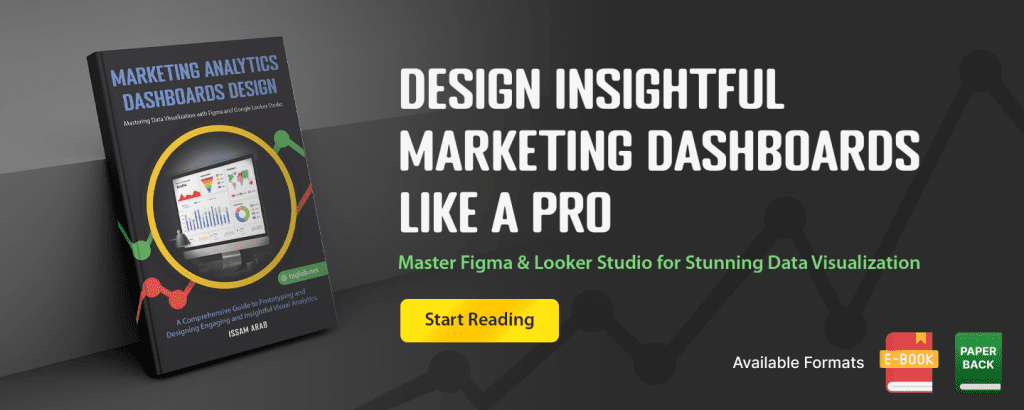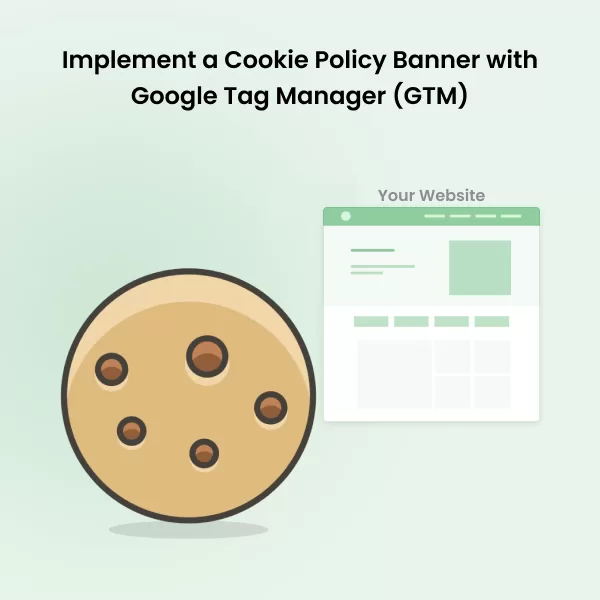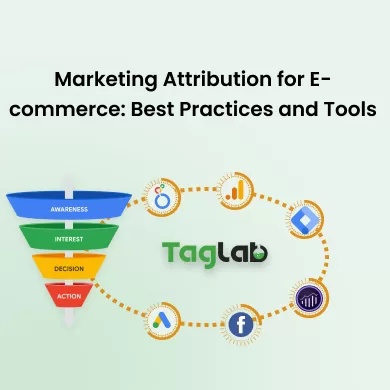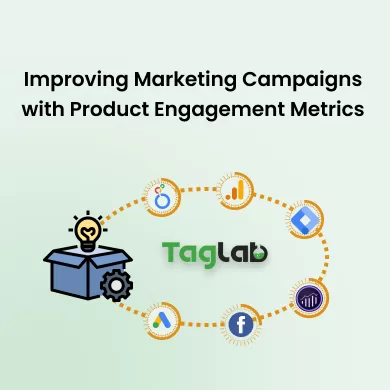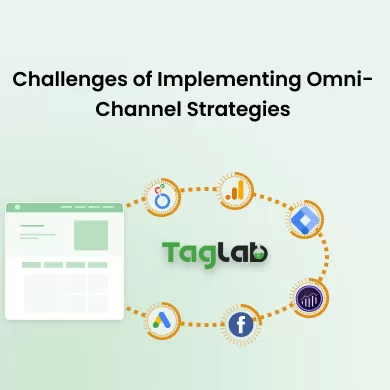Your cart is currently empty!
Digital Marketing Analytics Standard Operating Procedures (SOP)
- Understanding Analytics SOP. Why do you need one?
- Designing an Effective Analytics SOP
- Forecasting the Analytics Solution Design in the SOP
- Risk Management in Analytics SOP
- Final Words
- FAQS
- What is an Analytics Standard Operating Procedure (SOP) in digital marketing?
- Why is it important to integrate analytics from the ideation and UX design stages?
- How can businesses overcome operational challenges in implementing an analytics SOP?
- What is the role of forecasting in the analytics solution design?
- Why is continuous content adaptation important in digital marketing analytics?
- How can standardizing processes reduce dependency on the analytics team?
Establishing an effective Analytics Standard Operating Procedure (SOP) ensures that every step in your digital customer journey delivery, from ideation to development, incorporates robust analytics tracking and analysis. This article provides a high-level overview of crafting an SOP as a process that guarantees consistent data quality, efficient implementation, and strategic collaboration across various teams involved in the digital experience.
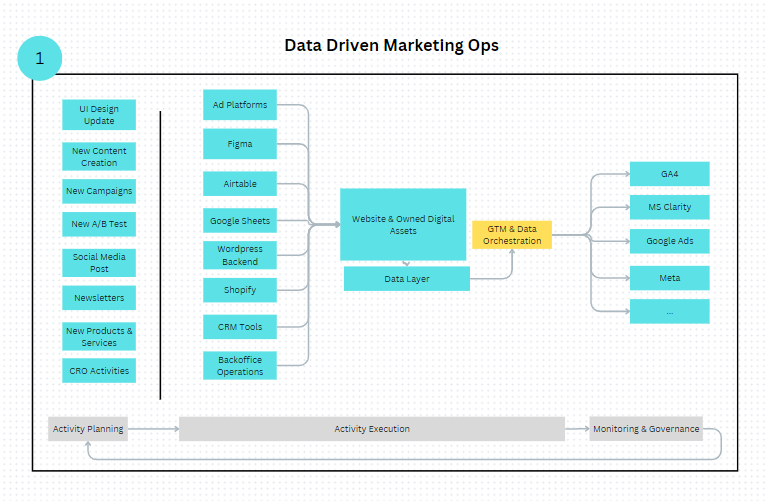 Understanding Analytics SOP. Why do you need one?
Understanding Analytics SOP. Why do you need one?
An Analytics Standard Operating Procedure (SOP) is a documented framework that guides the systematic execution of analytics-related tasks within an organization. It ensures consistency, accuracy, and efficiency in data collection, analysis, and reporting, ultimately supporting informed decision-making. An effective analytics SOP includes several key components: data collection guidelines, implementation procedures, quality assurance measures, and reporting standards. Together, these elements form the backbone of a robust analytics strategy, ensuring that data is collected and analyzed in a manner that supports business objectives.
The Role of Analytics in Digital Experience Delivery
Integrating analytics from the earliest stages of ideation and design ensures that tracking mechanisms are seamlessly incorporated into the final product. This process begins with close collaboration between analytics specialists, designers, and developers. Designers must understand the requirements for data collection and integrate tracking elements into the UI/UX design. This early collaboration helps avoid retroactive adjustments and ensures that analytics is baked into the product from the ground up.
Development teams then work closely with analytics experts to implement and test tracking codes, ensuring they function correctly. This collaboration continues through the development cycle, with ongoing testing to maintain accuracy and reliability. By embedding analytics into the digital experience from the beginning, businesses can create more data-informed designs that drive better user engagement and business outcomes.
Designing an Effective Analytics SOP
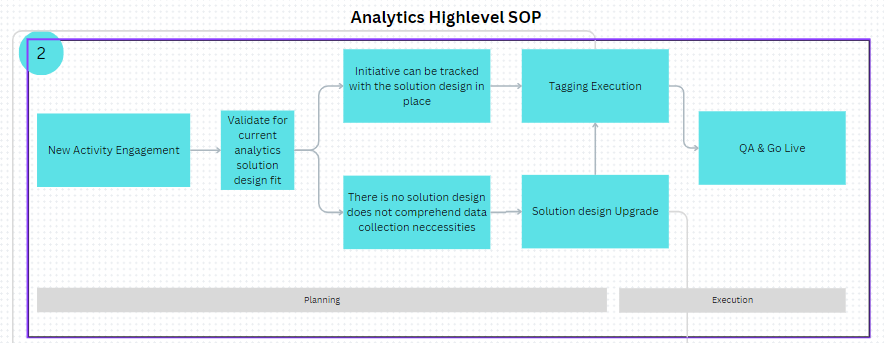
Designing an effective analytics SOP starts with identifying clear business objectives. These objectives guide the analytics strategy by defining what the organization aims to achieve with its data. Key performance indicators (KPIs) are then determined to measure success against these goals. Involving key stakeholders throughout this process is crucial. Regular meetings between analytics specialists, designers, brand managers, product owners, developers, or any other team members involved facilitate discussions that ensure the SOP addresses all necessary perspectives.
Feedback mechanisms are also essential, providing continuous opportunities for stakeholders to offer input and suggest improvements. This collaborative approach ensures that the analytics SOP remains aligned with the broader business strategy and adapts to evolving needs.
Forecasting the Analytics Solution Design in the SOP
One of the critical aspects of a successful Analytics Standard Operating Procedure (SOP) is forecasting the analytics solution design. It is essential to plan the analytics tracking well in advance to prevent it from becoming a bottleneck that delays the go-live of digital experiences. Ensuring that the analytics tracking is ready and aligned with the launch timeline is crucial to avoid launching a digital experience without the necessary tracking mechanisms in place.
Forecasting involves anticipating the requirements for analytics tracking, especially for significant initiatives and campaigns. These high-impact activities require precise data collection to measure their effectiveness and ROI accurately. By forecasting these needs, businesses can allocate resources effectively, ensuring that the analytics team has ample time to design and implement the necessary tracking solutions.
The importance of tracking key initiatives and campaigns cannot be overstated. Without proper tracking, it becomes challenging to evaluate the performance of marketing efforts, understand user behavior, and make data-driven decisions. By forecasting the analytics solution design, businesses can ensure that every campaign and initiative is meticulously tracked from the moment it goes live, providing valuable insights that drive continuous improvement and optimization.
Operational Challenges and Solutions
Organizations often face several challenges in implementing and maintaining an analytics SOP. Data silos, where data is fragmented across different systems, can hinder comprehensive analysis. Resource limitations, such as limited budget or manpower, can also impact the effectiveness of analytics implementation.
Solutions to these challenges include integrating data sources to eliminate silos and prioritizing key metrics to focus resources on the most critical data points. By addressing these obstacles proactively, businesses can create a more efficient and effective analytics operation.
Digital Experience Delivery
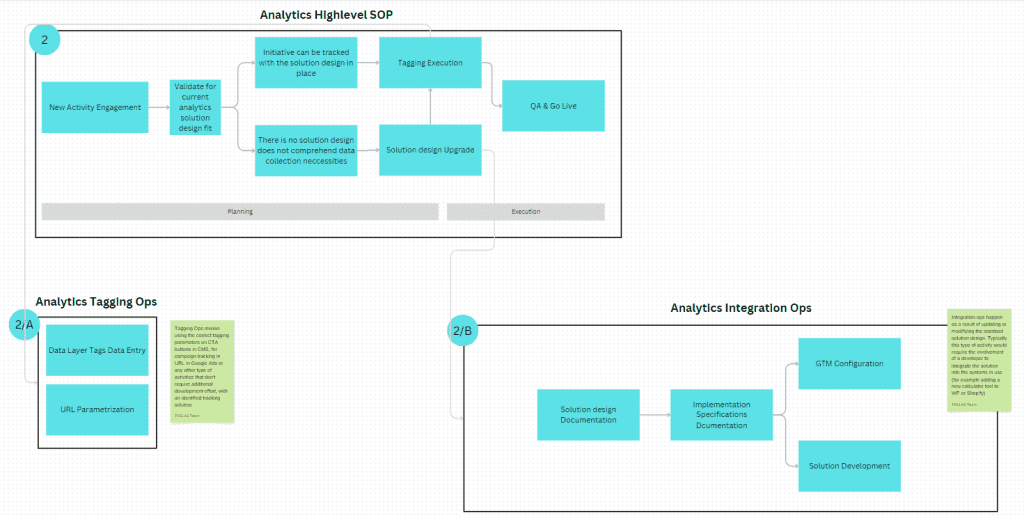
The digital experience delivery process begins with ideation and UX design, progressing through development and deployment. This journey includes brainstorming and conceptualizing the digital product, ensuring alignment with business objectives and user needs. During the UX design phase, user-friendly designs are created to facilitate seamless user experiences.
In the development phase, the product is built, and analytics tracking codes are integrated according to the tagging plan. A tagging plan is essential for effective analytics implementation. It defines the tagging strategy, outlining what events and interactions need to be tracked. Documentation provides clear instructions on tagging requirements and placement, while continuous collaboration between analytics teams, designers, and developers ensures that tags are integrated and tested throughout the development process.
Implementing Analytics Solutions
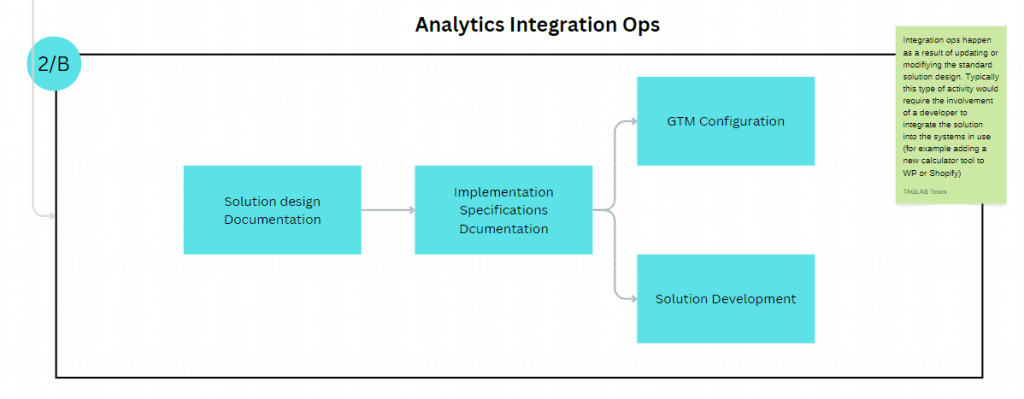 Integration with development processes involves including analytics requirements in the initial project planning phases so that data layers, tracking scripts, or other mechanisms that must be developed are taken into consideration, and continuously tested tags throughout the development cycles to ensure accuracy. By embedding analytics into the development workflow, businesses can ensure that every new feature or update is tracked and analyzed effectively.
Integration with development processes involves including analytics requirements in the initial project planning phases so that data layers, tracking scripts, or other mechanisms that must be developed are taken into consideration, and continuously tested tags throughout the development cycles to ensure accuracy. By embedding analytics into the development workflow, businesses can ensure that every new feature or update is tracked and analyzed effectively.
Continuous Content Adaptation
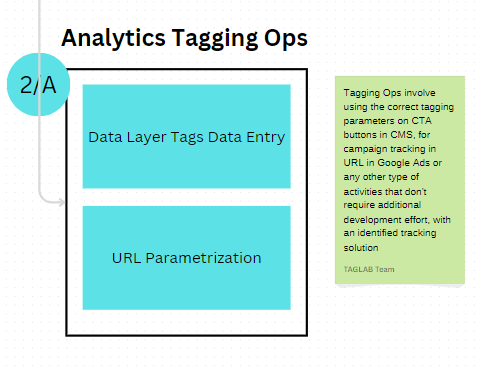 In the fast-paced digital landscape, continuous content adaptation is necessary to keep marketing efforts relevant and engaging. This often involves making small but frequent updates, such as daily changes to banners or promotional content. Involving the analytics team in these updates, or at least following their directives, is crucial to ensure that each change is accurately tracked and analyzed.
In the fast-paced digital landscape, continuous content adaptation is necessary to keep marketing efforts relevant and engaging. This often involves making small but frequent updates, such as daily changes to banners or promotional content. Involving the analytics team in these updates, or at least following their directives, is crucial to ensure that each change is accurately tracked and analyzed.
For instance, if a banner promoting a new product is updated daily, it must be tagged correctly to capture user interactions and engagement metrics. This allows the analytics team to assess the effectiveness of each version of the banner and provide insights into what resonates best with the audience. This continuous feedback loop supports agile marketing strategies, enabling businesses to adapt quickly to market changes and user preferences.
To reduce dependency on the analytics team and accelerate the time to go live, it is beneficial to standardize as much of the process as possible. Standardization can be achieved by creating data dictionaries or content taxonomies with preset tagging naming conventions. These tools provide a clear framework for tagging and tracking various content types, reducing the need for constant input from the analytics team.
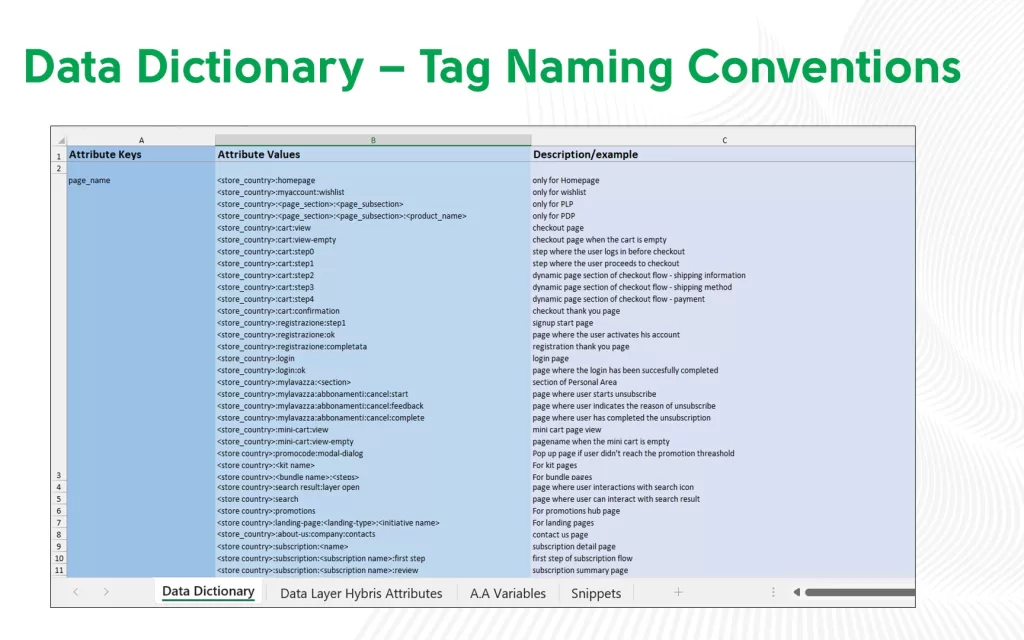 Additionally, clarifying the evident parts of the process in the SOP where the analytics team is not involved can streamline operations. For example, establishing clear guidelines for routine tagging tasks or common updates ensures that other team members can implement these changes without delay, freeing up the analytics team to focus on more complex tasks.
Additionally, clarifying the evident parts of the process in the SOP where the analytics team is not involved can streamline operations. For example, establishing clear guidelines for routine tagging tasks or common updates ensures that other team members can implement these changes without delay, freeing up the analytics team to focus on more complex tasks.
Ensuring Data Quality and Accuracy
Maintaining data quality involves several best practices. Standardized data entry ensures consistency in how data is recorded, while regular data cleansing removes inaccuracies and redundancies. Techniques for validating and verifying data include cross-referencing data from different sources for consistency and using tools to identify and investigate unusual data patterns.
By implementing these best practices, businesses can ensure that their data remains accurate and reliable, providing a solid foundation for decision-making.
Risk Management in Analytics SOP
Risk management is a crucial aspect of a robust Analytics Standard Operating Procedure (SOP). Identifying potential risks and assessing their impacts allows businesses to develop effective mitigation strategies. Implementing contingency plans ensures preparedness for unexpected issues, such as data breaches or system failures.
To manage risks effectively, it’s important to involve internal teams and external service providers in complying with the SOP processes and flow. This includes implementing RACI (Responsible, Accountable, Consulted, Informed) processes to clearly define roles and responsibilities. Regular team meetings and huddles are essential to align stakeholders on the SOP and set clear expectations. These gatherings also serve as a platform for addressing any concerns and ensuring everyone is on the same page.
Escalation points should be clearly defined within the SOP to handle any issues that arise promptly and efficiently. This helps in quickly resolving problems that could potentially disrupt the analytics operations. Aligning new team members with the SOP is equally important, ensuring they understand the processes and their roles within the framework.
Project Management for Analytics SOP
Effective project management is essential for implementing an analytics SOP. Detailed project plans outline the steps and timelines for implementation, with key milestones to track progress and ensure timely completion. Proper resource management ensures the availability of necessary tools and personnel, including budgeting for analytics tools and assembling teams with the right mix of skills and expertise.
This structured approach to project management helps ensure that the analytics SOP is implemented effectively and efficiently.
Training and Development
Continuous training ensures that teams are equipped with the latest knowledge and skills. Regular workshops and seminars provide ongoing education, while certification programs encourage team members to stay current with industry standards. Providing access to online courses, tutorials, and other learning materials supports continuous learning.
Support channels, such as help desks or dedicated support teams, offer assistance when needed, ensuring that teams can effectively implement and maintain the analytics SOP.
Collaboration and Communication
Ensuring cross-departmental cooperation enhances the effectiveness of the analytics SOP. Regular inter-departmental meetings facilitate discussions on analytics needs and progress, while collaborative tools enable efficient communication and collaboration. Clear communication channels, including comprehensive documentation of processes and procedures, ensure timely and accurate information sharing.
Establishing clear reporting structures for analytics insights helps ensure that data-driven decisions are based on accurate and up-to-date information.
Tools and Technologies
Selecting the right tools is crucial for effective analytics. The evaluation criteria for choosing analytics tools should be based on specific business needs, ensuring that the tools align with organizational goals and facilitate data-driven decision-making. Regular reviews and updates of these tools are essential to keep pace with evolving requirements and technological advancements.
In addition to analytics tools, project management platforms such as ticketing systems and Kanban boards (e.g., Jira, Trello) play a vital role in organizing and tracking analytics projects. These platforms help streamline workflows, assign tasks, monitor progress, and ensure that projects are completed on time. They also provide transparency and accountability, making it easier to manage multiple projects simultaneously.
Documentation tracking tools, like wikis and dedicated documentation software (e.g., Confluence, Notion), are equally important. These tools allow teams to create, share, and update documentation in a centralized repository. This ensures that all stakeholders have access to the latest information, guidelines, and procedures, reducing confusion and maintaining consistency across the organization.
Visual process creation tools, such as Canva, Miro, and Figma, can be used to create detailed visual representations of processes, workflows, and data flows. These tools help teams visualize complex analytics processes, making it easier to understand and communicate the steps involved. They can also be used for brainstorming sessions, design sprints, and collaborative planning, fostering creativity and innovation.
Regular maintenance and updates keep these tools functioning optimally, while access to technical support helps troubleshoot and resolve issues quickly.
Continuous Improvement
Continuous improvement involves regular feedback loops and iterative refinement processes. Regularly gathering feedback from stakeholders helps identify areas for improvement, while developing and implementing action plans based on feedback ensures that the analytics SOP evolves with changing needs.
Continuous improvement cycles and benchmarking against industry standards help maintain excellence and drive ongoing enhancements in the analytics operation.
Final Words
Implementing a robust Analytics Standard Operating Procedure (SOP) in digital marketing is crucial for leveraging data to drive strategic decisions. By integrating analytics from the ideation and UX design stages through to development and deployment, businesses can ensure comprehensive tracking and analysis. Collaboration among designers, brand managers, developers, and analytics specialists is essential to create an effective tagging plan that aligns with business objectives.
Overcoming challenges like data silos and resource constraints through strategic planning and focusing on key metrics ensures data integrity and reliability. Continuous training, project management, and staying updated with emerging trends and technologies further enhance the effectiveness of the analytics SOP.
Ultimately, the success of an analytics SOP depends on consistent application, stakeholder commitment, and regular updates. Prioritizing data quality, fostering collaboration, and committing to continuous improvement will help businesses maximize the value of their analytics efforts, driving informed decisions and digital marketing success.
FAQS
What is an Analytics Standard Operating Procedure (SOP) in digital marketing?
An Analytics Standard Operating Procedure (SOP) is a documented framework that guides the systematic execution of analytics-related tasks within an organization. It ensures consistency, accuracy, and efficiency in data collection, analysis, and reporting, ultimately supporting informed decision-making.
Why is it important to integrate analytics from the ideation and UX design stages?
Integrating analytics from the ideation and UX design stages ensures that tracking mechanisms are seamlessly incorporated into the final product. This early integration allows for accurate data collection and analysis from the beginning, facilitating data-driven decisions and optimizing the digital experience.
How can businesses overcome operational challenges in implementing an analytics SOP?
Businesses can overcome operational challenges by integrating data sources to eliminate silos, prioritizing key metrics to focus resources effectively, and ensuring continuous collaboration among stakeholders. Strategic planning and focusing on critical data points also help address resource limitations and improve the efficiency of analytics implementation.
What is the role of forecasting in the analytics solution design?
Forecasting in the analytics solution design involves planning the tracking mechanisms well in advance to prevent delays in the go-live process. It ensures that analytics tracking is ready and aligned with the launch timeline, avoiding the risk of launching digital experiences without necessary tracking in place. Forecasting also allows businesses to allocate resources effectively for significant initiatives and campaigns.
Why is continuous content adaptation important in digital marketing analytics?
Continuous content adaptation keeps marketing efforts relevant and engaging. Frequent updates, such as daily changes to banners or promotional content, need to be accurately tracked and analyzed to assess their effectiveness. Involving analytics teams in these updates ensures precise data collection, supporting agile marketing strategies and enabling quick adjustments based on user feedback.
How can standardizing processes reduce dependency on the analytics team?
Standardizing processes, such as creating data dictionaries or content taxonomies with preset tags, reduces the need for constant input from the analytics team. Clear guidelines for routine tagging tasks allow other team members to implement changes without delay, freeing up the analytics team to focus on more complex tasks. This accelerates the time to go live and ensures efficient analytics implementation.
